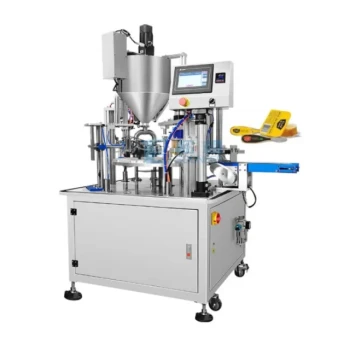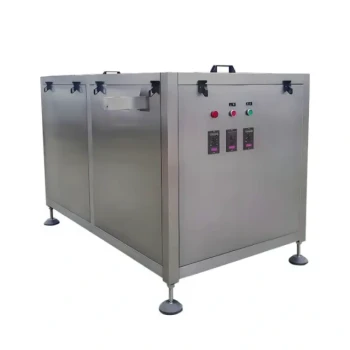At its core, a honey filling machine ensures hygiene by isolating the product from external contaminants. It achieves this through a combination of food-grade materials, which do not leach into or react with the honey, and an enclosed system that minimizes its exposure to air, dust, and human contact from the holding tank to the final container.
A filling machine's primary role in hygiene is not just about cleanliness, but about control. By automating and enclosing the process, it creates a predictable, repeatable, and verifiable environment that systematically reduces the risk of contamination at every stage.

The Core Principles of Hygienic Design
To maintain the purity of a sensitive product like honey, machines are built around several key principles. These design choices are not accidental; they are fundamental to ensuring food safety and product quality.
Food-Grade Material Construction
The most critical element is the material that touches the honey. Reputable machines almost exclusively use food-grade stainless steel (like types 304 or 316L) for all contact parts, including the hopper, pipes, valves, and filling nozzle.
This material is chosen because it is non-porous, corrosion-resistant, and non-reactive. Unlike plastics or lower-grade metals, stainless steel will not harbor bacteria in microscopic cracks or impart any undesirable flavor or chemical contaminants into the honey.
Enclosed Product Pathways
From the moment honey is loaded into the machine's hopper until it is dispensed into the jar, it travels through a completely enclosed system. This pathway of pipes and valves shields the honey from airborne contaminants like dust, yeast, and bacteria.
This design drastically reduces the risk of contamination compared to manual or open-air filling methods, where environmental exposure is a constant threat.
Design for Easy Cleaning
A machine is only as hygienic as its last cleaning. Modern filling machines are designed for easy and thorough sanitation. Components are often engineered for quick disassembly without special tools, allowing operators to access every surface that comes into contact with the honey.
Many industrial-scale machines also incorporate Clean-in-Place (CIP) systems. These automated systems circulate cleaning solutions, rinses, and sanitizers through the entire machine at the correct temperature and pressure, ensuring a consistent and verifiable level of cleanliness between batches.
Beyond Contamination: Ensuring Product Integrity
True hygiene extends beyond simply preventing germs. It also involves maintaining the product's quality and stability, which a filling machine supports through precision and proper sealing.
The Role of Precision Filling
Accuracy is a key feature of hygiene. The machine's system of sensors, valves, and actuators dispenses a precise, predetermined volume of honey into each container.
This prevents underfilling, which disappoints customers, and overfilling. An overfilled jar can cause honey to get on the rim, compromising the seal and creating a sticky surface that can attract pests or mold during storage.
The Final Seal
Once the container is filled, it must be immediately and effectively sealed. The machine's process ensures a clean transfer, leaving the container rim free of product. This allows the cap or lid to create a perfect airtight seal.
This final step is crucial. It locks out oxygen and moisture, preventing spoilage and fermentation, thereby preserving the honey's quality and extending its shelf life.
Understanding the Trade-offs
While effective, a honey filling machine's hygienic operation is not automatic. It depends on proper selection and operation.
The Risk of Improper Cleaning
A complex machine with many parts can be a source of contamination if not cleaned meticulously. A poorly executed cleaning protocol, whether manual or automated, can leave behind residue that fosters microbial growth.
Viscosity and Temperature Mismatches
Honey's viscosity changes dramatically with temperature. If a machine is not properly calibrated for the specific viscosity of the honey being filled, it can lead to drips, strings, and messy operation. This not only wastes product but also compromises the clean environment around the filling station.
The Human Element
Even with an automated system, operator error remains a risk. Improper setup, incorrect settings, or failing to follow sanitation protocols can undermine the machine's inherent hygienic design.
Making the Right Choice for Your Operation
Choosing a machine requires matching its features to your specific production goals.
- If your primary focus is artisanal quality and small batches: Prioritize a machine that is simple to disassemble and clean manually, ensuring you have full control over the sanitation process.
- If your primary focus is high-volume production and efficiency: Invest in a machine with an automated Clean-in-Place (CIP) system to guarantee consistent, verifiable cleaning with minimal downtime.
- If your primary focus is product versatility: Select a machine with adjustable settings for flow rate and volume, and that can handle a wide range of honey viscosities and container sizes.
Ultimately, the right honey filling machine acts as a reliable partner in delivering a safe, pure, and high-quality product to your customers.
Summary Table:
| Hygienic Feature | How It Protects Your Honey |
|---|---|
| Food-Grade Materials | Uses non-porous, corrosion-resistant stainless steel to prevent contamination and flavor transfer. |
| Enclosed System | Shields honey from air, dust, and human contact from hopper to container. |
| Easy Cleaning Design | Allows for quick disassembly and thorough sanitation; often includes automated Clean-in-Place (CIP) systems. |
| Precision Filling | Prevents overfilling/underfilling to ensure a clean rim and a perfect, airtight seal on every jar. |
Ready to ensure the highest standards of hygiene and efficiency in your honey operation?
At HONESTBEE, we specialize in supplying commercial apiaries and beekeeping equipment distributors with robust, hygienic filling solutions designed for high-volume production. Our machines are built to protect your product's purity, streamline your workflow, and safeguard your brand's reputation.
Contact our experts today to find the perfect filling machine for your specific needs and volume requirements.
Visual Guide

Related Products
- Pneumatic Double Nozzle Honey Filling Bottling Packaging Machine
- Precision Automated Packaging Turntable Honey Spoon Filling Sealing Packing Machine
- Professional Thermostatic Conical Honey Melter
- Honey Concentrating Vacuum Heating Thickening Machine Dehumidifier for Honey
- High Quality Honey Dehumidifier Dryer Thickening Machine for Beekeeping
People Also Ask
- What bottling equipment is used after honey filtering? Choose the Right System for Your Scale
- What is the filling accuracy of an automatic honey filling machine? Achieve ±0.5% Precision for Your Apiary
- How does production volume influence the choice of a honey packaging machine? Scale Your Operation Efficiently
- What are the types of bottling machines used for honey? Find the Right Filler for Your Scale
- What are the main differences between automated and manual honey filling? Scale Your Bottling Operation



















